This article appeared in the 23 July 1913 number of the journal 'Schiffbau' under the title 'Rettungsboote für Seeschiffe.' The original article in German can be read online at the HathiTrust site:
http://babel.hathitrust.org/cgi/pt?id=mdp.39015080302998;view=1up;seq=888
Translated to English by Ralph Currell with the assistance of Google Translate. The 'Nautical Pocket Dictionary' at https://archive.org/details/completenautical00bartrich was also consulted for some technical terms.
Translators comments are in square brackets as shown here: [This is a comment.]
By Franz V. Meyer.
The problem of lifeboats for seagoing vessels has received renewed attention in shipping circles as a result of the "Titanic" catastrophe. The Board of Trade has swiftly embraced the principle, long followed by other shipping regulators, of having to provide a means of rescue for every person on board. According to its new regulations issued in March 1913 (1), "boats for all" are required, and strict rules are also laid down concerning the construction of the boats.
As these English rules, which affect not only English ships but also all other foreign vessels sailing in English ports, are not universally approved, international negotiations are underway to enable uniform regulation of the boat issue.
It is now impossible on the larger passenger steamers to carry a sufficient number and size of boats in the form of the usual lifeboats, such that there is room for all persons on board. One is forced to arrange a larger number of the required boats so that they can be stacked on board several over each other. These so-called "collapsible boats", whose upper part is unfolded only in the case of use, have been in use for many years. Their seaworthiness, stability and strength have been unsatisfactory however, and their construction has therefore been more carefully considered. This has created a whole new kind of boat, the so-called "decked boats", that already appear in the new Board of Trade rules.
The safest boats are generally known to be those of the Coastal Rescue teams. They are, in some respects, the ideal models of "decked boats," for they have a double bottom, are completely unsinkable, empty themselves when swamped, and straighten up again when capsized. However, they are too heavy for use as a ship's boat.
Many have questioned the need to carry the prescribed large number of boats. The shipowners incur tremendous costs, and there is a danger that the ships' stability and sea properties will suffer from the large weight of the davits, etc. mounted so high.
It is also undeniable that in stormy and high seas conditions can occur, which prevent the effective use of the lifeboats.
But it must be pointed out that experience has shown that most of the accidents occurring to large ships are not caused by bad weather but by currents, icebergs, drifting wrecks, fire or fog. If the sea is reasonably calm, it will always be possible to load and lower all the boats, while preserving the necessary calm and serenity of the crew and passengers.
Closely related to the whole issue of the boats are the accommodation of the boats aboard the ships and the boat launching devices.
The boats should be on the one hand safe from sea and other damage; on the other hand, to fulfil their purpose, they should be convenient and fast to load and lower.
The construction of boat davits, in their old form and in the quadrant form introduced by Welin, are assumed to be well known.
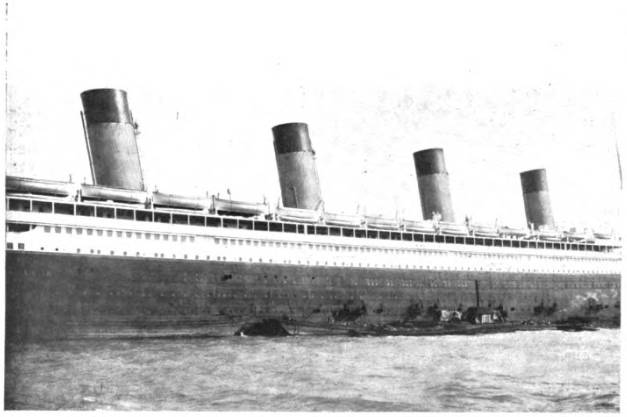
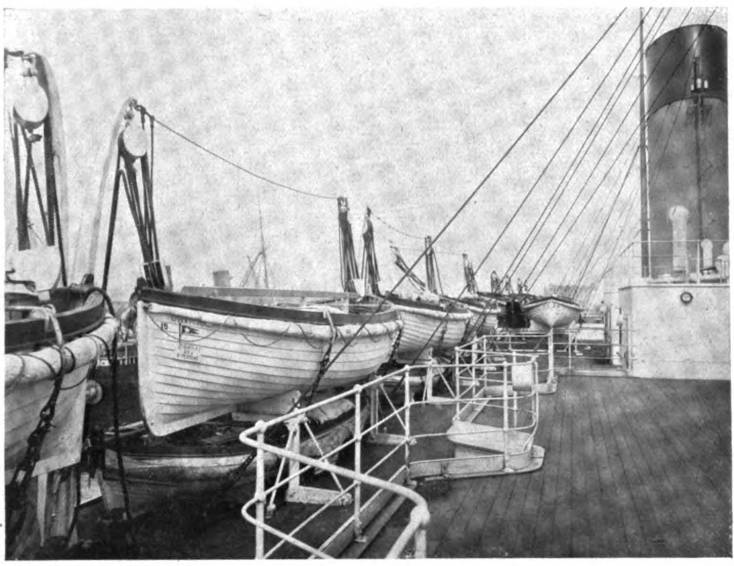
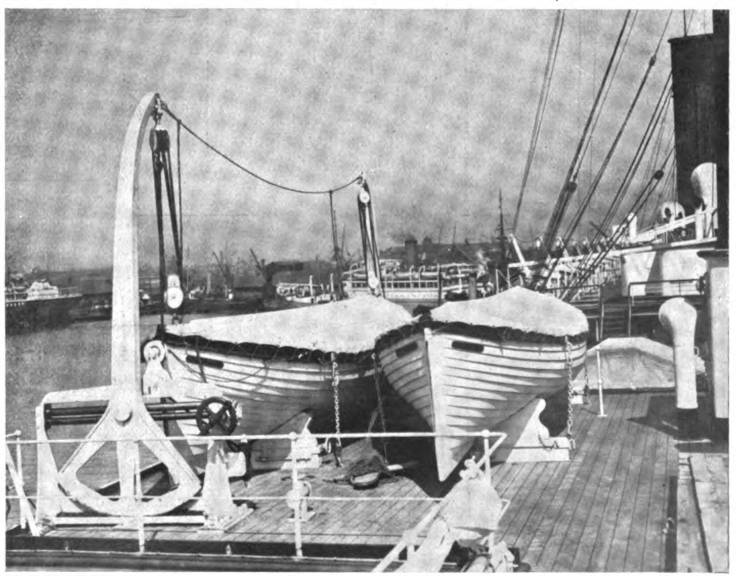
Some innovations in the field of boat installation are shown in the accompanying illustrations.
The "Olympic", sister ship of the unfortunate "Titanic", now has 68 boats instead of the previous 20. Figures 1 and 2 show how the boats are arranged so that a "decked boat" and a normal lifeboat are placed one above the other. Figure 3 shows the accommodation of two normal boats side by side, both of which can be swung out and lowered one after the other with the same davit pair. [Note: figure 3 is in fact the liner "Aquitania".] In Fig. 4 and 5, the boat installation on the "Imperator" is shown. In this ship, a part of the boat outfit is no longer, as usual, on the top deck, but housed on a lower deck. The arrangement of the launching devices can readily be seen in Fig. 5. The usefulness of the mechanism was tested at the first grounding of the steamer on the Elbe when it was used to lighten the ship as much as possible. The unproven installation worked without delay, though it was serviced by inexperienced people. The large 75-person boats were safely and steadily brought to the water from the still considerable height of about 15 to 20 m at a speed of about 1.5 m per second.

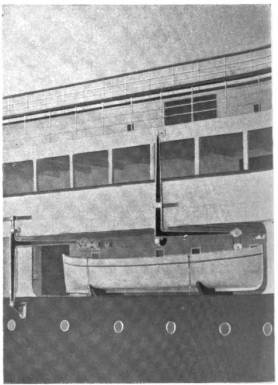
As far as the construction of the boats themselves is concerned, we have now three different boat types, as mentioned at the beginning of this article:
1. lifeboats.
2. decked boats.
3. collapsible boats.
The construction of fully-fledged lifeboats is unlikely to change much from what is currently required by regulators. Experience has shown that it is advantageous to make the boats quite full at the ends and give them a good deal of sheer. The B.o.Tr. gives certain rules about these two points.
An innovation, which probably has some advantages, is that the outboard cork fenders are no longer fastened just below the gunwale, but approximately at the waterline.
The miscellaneous construction of boats either entirely of wood or in the type of so-called Francis boats [of partly metal construction] is assumed to be known. (2)
Special mention should be made of the seamless steel boats of Wakefield's "Seamless Steel Boat Co. Ltd." Fig. 6 shows the fabrication workshops of this company.
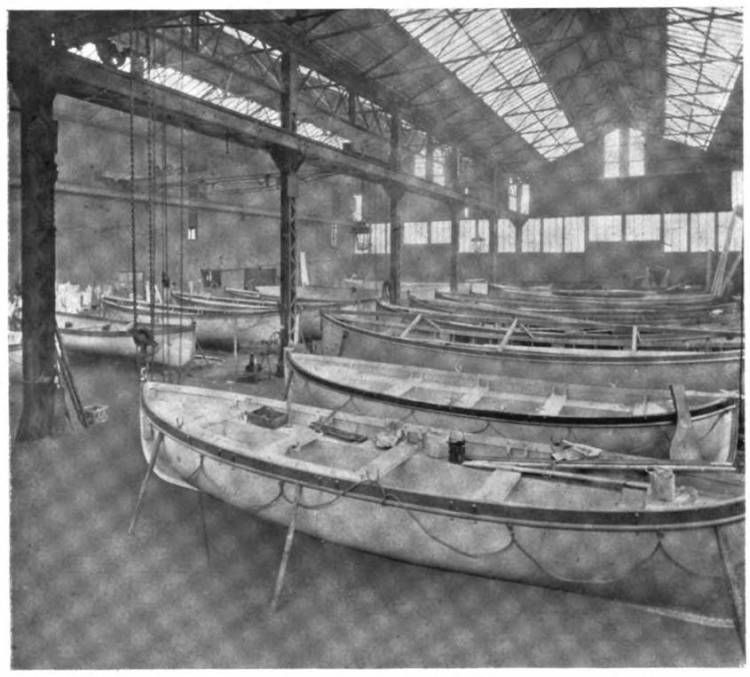
The production of these boats happens in the following way. Each of the two steel halves is hydraulically pressed into the required shape from a single steel plate. Then the two halves are riveted with a flat iron placed in between. The required air cases are made either from galvanized iron, wood, yellow metal or copper as desired. Thwarts and gunwale are made of elm or teak wood. The gunwale is sometimes made of pressed steel.
The merits of these boats consist chiefly in the following: they are insensitive to any temperature influences; as a result, they never leak; they do not break under hard load, as for example when they are struck by waves against the ship's side, or are torn by a sea out of their chocks.
Dents can be easily removed on board with a mallet; the boats remain buoyant even with big dents and deformities. If an annual thorough cleaning and renewal of the paint is taken care of, then they remain usable at least twice as long as wooden boats. There are such boats which are 15 years old and still as good as new. The boats can not be destroyed by fire.
The Seamlees Steel Boat Co. has already delivered over 6,000 such lifeboats to a large number of shipping companies. The boats are fully galvanized, coated inside with Bitumastic Solution and the bilge is poured with Bitumastic cement.
The table below gives the main dimensions, etc. of these boats.
| Length m | Width m | Height m | Number of persons | Weight of the boat with copper air cases kg |
| 5.49 | 1.83 | 0.61 | 12 | 610 |
| 6.10 | 1.83 | 0.74 | 16 | 686 |
| 6.10 | 1.98 | 0.76 | 18 | 711 |
| 6.71 | 1.98 | 0.74 | 20 | 762 |
| 7.32 | 1.98 | 0.76 | 23 | 889 |
| 7.32 | 2.03 | 0.83 | 26 | 965 |
| 7.93 | 2.13 | 0.83 | 29 | 1067 |
| 7.93 | 2.20 | 0.91 | 32 | 1118 |
| 7.93 | 2.28 | 0.91 | 35 | 1118 |
| 7.93 | 2.44 | 0.99 | 40 | 1143 |
| 8.24 | 2.28 | 1.06 | 42 | 1270 |
| 8.54 | 2.36 | 1.06 | 44 | 1321 |
| 8.54 | 2.44 | 1.06 | 47 | 1321 |
| 9.14 | 2.59 | 1.06 | 53 | 1372 |
The construction of the new "decked boats", which, as we have said, originated from the old "collapsible boats", naturally constitutes a topic of keen interest for boat builders. We are aware that several German companies have already made very useful designs for testing; regrettably no material was provided to us for publication.
On the other hand, we are able to report in detail about some interesting new foreign designs.
The "Engelhardt-Decked Life Boat Co" in Copenhagen, Krystalgade 15, on whose former "collapsible boats" this journal extensively reported in the 1903/04 edition on page 624, has now constructed their boats using the principle then described, so that they are recognized as "Decked Life Boats" by the Board of Trade.
The float is now properly built in Wakefield boat shape and clinker or carvel planked. Its filling consists only of ordinary cork. Other substances, such as kapok and impregnated or pressed cork, have not proven successful in operation.
The Engelhardt boats are completely unsinkable, even if the bottom has been pushed in, the canvas sides have been torn or the stoppers of the bottom holes have been lost, because the floating body carries more people than the space allowed for the boat.
The design of the Engelhardt boats is so strong that they can be thrown overboard in an emergency. One can then easily climb aboard in the water and unfold the canvas part with little effort.
The boats have proven to be durable; for example, boats delivered to the Oestasiatisk Kompagni in Copenhagen in 1903 are still as good as new.
Of course, the canvas cover must be renewed from time to time. But this is a very simple job that can be done in a few hours without the help of professionals.
Fig. 7 clearly shows the shape and construction of these new Engelhardt boats, while the following table contains the main dimensions and other details.
| Length m | Width m | Height m | Volume cbm | Number of persons according to B.o.T. | Weight kg |
| 2.74 | 1.22 | 0.51 | 1.02 | 4 | 95 |
| 3.66 | 1.42 | 0.66 | 2.04 | 8 | 230 |
| 4.27 | 1.68 | 0.69 | 2.91 | 11 | 295 |
| 4.88 | 1.83 | 0.76 | 4.08 | 16 | 415 |
| 5.48 | 1.98 | 0.76 | 4.95 | 21 | 525 |
| 6.41 | 2.21 | 0.84 | 7.10 | 28 | 685 |
| 7.01 | 2.36 | 0.84 | 8.32 | 33 | 785 |
| 7.93 | 2.67 | 0.86 | 11.84 | 43 | 1000 |
| 8.54 | 2.89 | 0.89 | 13.13 | 50 | 1250 |
The adjoining figures 8-11 show recent versions of Engelhardt boats.
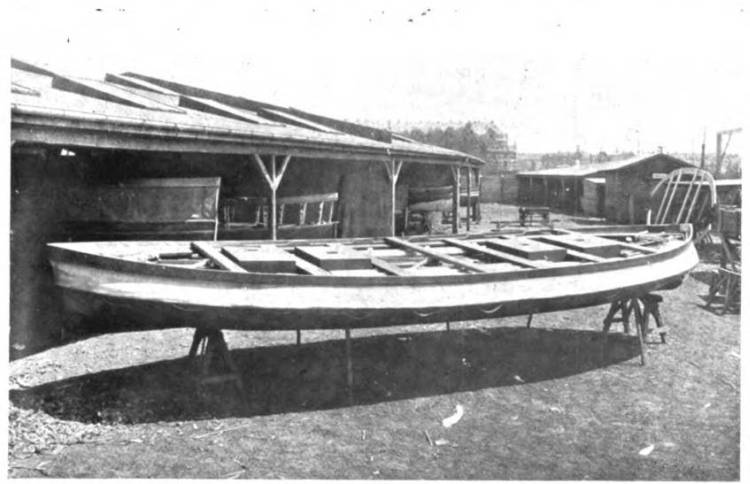
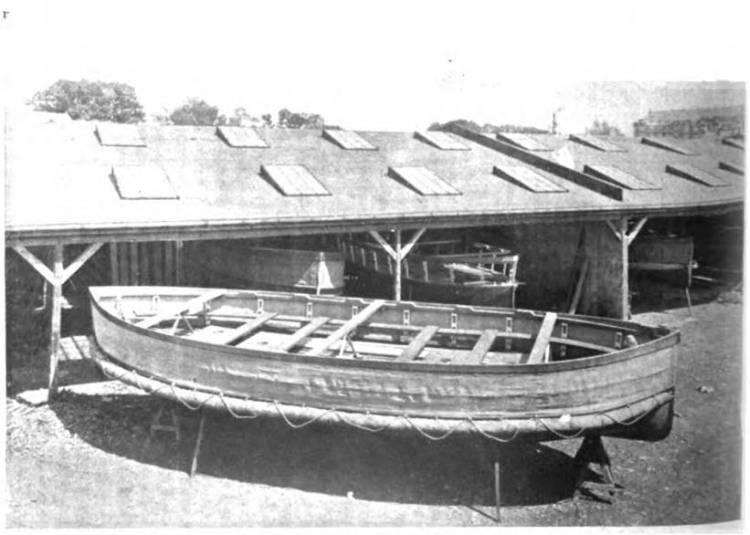
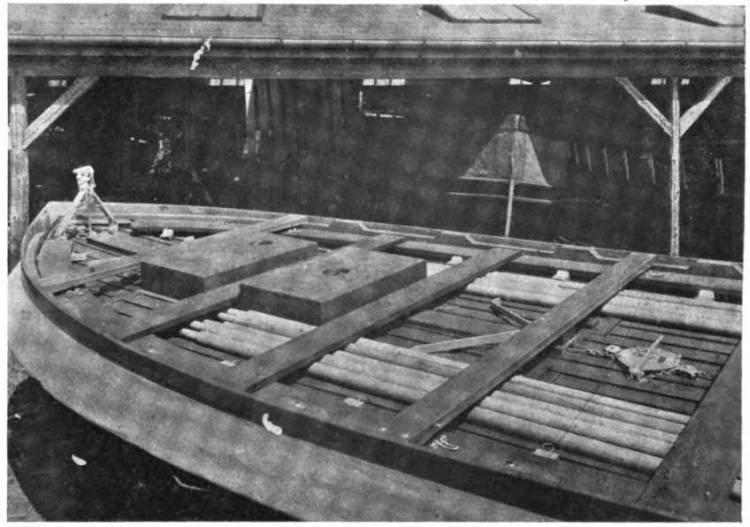
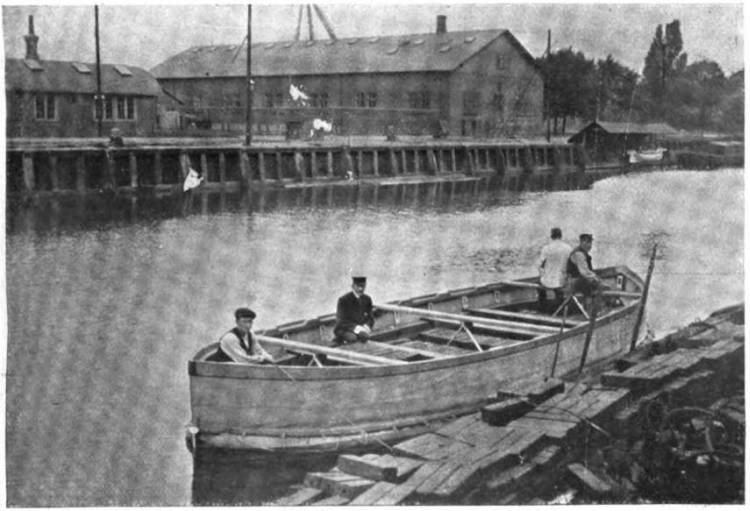
Figures 8, 9 and 10 show the storage of the oars, the on-board and water tanks and the installation of the patented disengaging gear for the simultaneous release of both boat falls, as well as the construction and attachment of the hinged section supports. Figure 11 was taken on occasion of trials at the Danish State Shipyard on 3 June 1913. The boat is loaded here with 7200 kg, so that the deck is just at the waterline.
The decked Engelhardt boats are a bit heavier than Engelhardt's earlier collapsible boats, which are still manufactured, and whose main dimensions, etc., are contained in the following table.
| Length m | Width m | Height m | Volume cbm | Load capacity kg | Number of persons according to B.o.T. | Weight of the boat kg |
| 2.29 | 0.51 | 0.74 | 1.06 | 236 | 3 | 64 |
| 2.74 | 0.51 | 1.02 | 1.22 | 318 | 4 | 86 |
| 3.66 | 0.66 | 2.10 | 1.45 | 627 | 9 | 168 |
| 4.27 | 0.69 | 2.90 | 1.65 | 942 | 12 | 245 |
| 4.88 | 0.81 | 4.35 | 1.83 | 1314 | 19 | 341 |
| 5.48 | 1.95 | 0.81 | 5.25 | 1612 | 23 | 418 |
| 6.10 | 2.13 | 0.84 | 6.54 | 2157 | 28 | 558 |
| 6.41 | 2.13 | 0.84 | 6.86 | 2268 | 30 | 590 |
| 6.71 | 2.21 | 0.84 | 7.44 | 2465 | 32 | 636 |
| 7.01 | 2.29 | 0.84 | 8.04 | 2670 | 35 | 690 |
| 7.32 | 2.36 | 0.84 | 8.69 | 2883 | 38 | 749 |
| 7.62 | 2.49 | 0.84 | 9.53 | 3167 | 42 | 817 |
| 7.93 | 2.61 | 0.86 | 10.72 | 3464 | 47 | 899 |
| 8.54 | 2.74 | 0.89 | 12.48 | 3925 | 55 | 1022 |
| 9.14 | 2.89 | 0.91 | 14.52 | 4440 | 64 | 1158 |
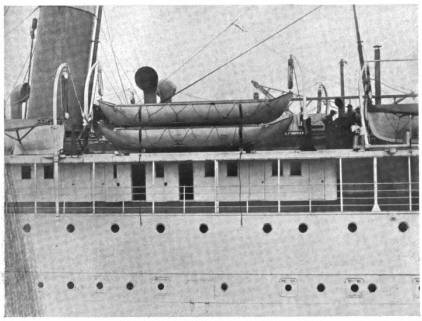
Another interesting innovation in the field of covered boats is the "Lundin boats" of "Welin Davit & Engineering Co. Ltd." in London E.C. The "Lundin boats" have a substantially different shape and construction, as can be seen from the figures above.
Fig. 12 shows the accommodation of two 7.95-m-long Lundin boats under Welin davits on the American troop transport "Kilpatrick." Figures 13 and 14 are included in the trials of these boats.
Figure 15 shows an embodiment proposed by the Welin Marine Equipment Co. of New York, to which we will return below.
The peculiar shape should make the boats very stable, safe, seaworthy and sustainable. Although they are somewhat expensive to buy, their great advantages of safety and seaworthiness, carrying capacity, space saving on deck, and easy maintenance may well secure their introduction.
The Lundin boats are built from strong galvanized steel plates. All seams are double riveted with countersunk, tinned rivets. The seams are provided with liners made of flannel and red lead to ensure tightness and resistance to rusting.
The floating body is divided by transverse bulkheads into eight watertight compartments. The deck is above the waterline and has scuppers through the bottom, so the boat will automatically drain when it is swamped. The hinged side and end boards set themselves in the erected state.
A manhole is provided in each section to allow the float to be overhauled and painted from the inside.
On each side a thick wooden fender is attached, increasing the load capacity and stability and ensuring a very effective protection against impact.
In the stowing position on board, two Lundin boats are about as tall as an ordinary lifeboat.
A Lundin boat has 20 to 25% more usable space than an ordinary lifeboat of the same length.
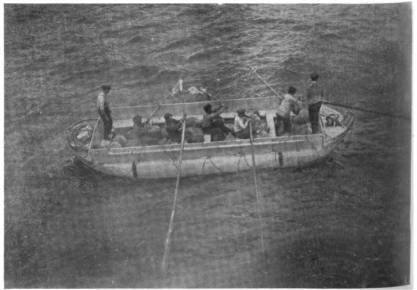
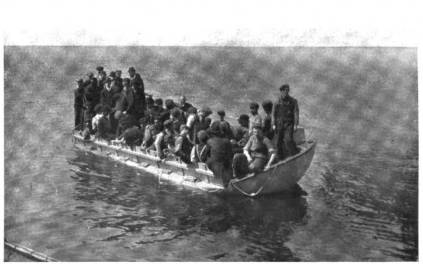
After making very rigorous trials of these boats, the U.S. Steamboat Inspection Service issued the following provisions: "Lundin-decked boats are allowed as lifeboats under davits up to half of the prescribed boat space to travel under davits, and are allowed to be carried two at a time under a davit pair. They must be fully equipped as lifeboats according to these regulations and should be measured according to the following rule: Cubic capacity = L X B X D X 0.9 cubic feet.
Where:
L = length over all in feet,
B = width over fenders in feet,
D = height from upper edge of keel to upper edge of gunwale in feet.
e.g. 28' X 9.5' X 2.5' X 0.9 = 598.5 Cub.Foot = 60 persons. These boats may also be used as rescue craft. This results in the following table for boats of different sizes:
| Length overall m |
Width overall m |
Height m |
Number of persons |
|---|---|---|---|
| 6.10 | 2.13 | 0.84 | 28 |
| 6.71 | 2.28 | 0.84 | 33 |
| 7.32 | 2.44 | 0.84 | 40 |
| 7.93 | 2.64 | 0.89 | 50 |
| 8.54 | 2.84 | 0.91 | 60 |
| 9.14 | 3.05 | 0.99 | 75 |
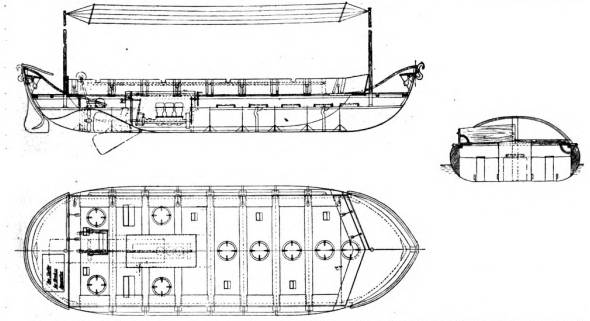
In-depth research into the best design and layout of boats aboard large seagoing vessels has led to the suggestion that boats as large as possible be used. It is also undeniable that if, for instance, the 68 boats now housed on the "Olympic" were replaced by about 24 larger ones of the same overall capacity, it would in many ways simplify matters.
The difficulties in designing the launching devices and the propulsion equipment for these large boats can be safely overcome by modern technical aids, such as electricity, oil engines, etc.
This is also the aim of the proposal by the American Welin Company, already mentioned above and shown in Fig. 15. The main dimensions of this boat are: 10.97 X 3.66 X 1.0 m.
It has seating for 100 people; Motor with screw and wireless telegraphy equipment. M.
Footnotes:
(1) See number from earlier this year.
(2) See Brix Bootsbau, 4th edition. Published by W. Ernst & Sohn. Berlin, Wilhelmstrasse.